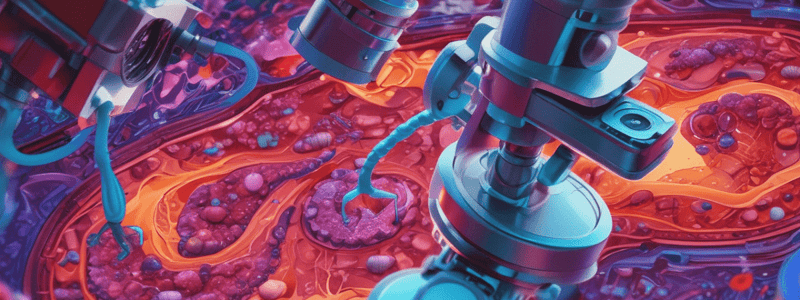Podcast
Questions and Answers
What is the resolving power of the human eye?
What is the resolving power of the human eye?
- 200 nm
- 7 nm
- 0.2 µm (correct)
- 10 µm
What is the typical size range of a eukaryote cell?
What is the typical size range of a eukaryote cell?
- 1 mm - 5 mm
- 100 µm - 500 µm
- 50 nm - 100 nm
- 10 µm - 50 µm (correct)
What is the thickness of cell membranes that need to be visualized?
What is the thickness of cell membranes that need to be visualized?
- 70 µm
- 700 nm
- 7 nm (correct)
- 7 µm
What type of microscope uses visible light and glass lenses?
What type of microscope uses visible light and glass lenses?
What is the highest resolution that visible light can provide?
What is the highest resolution that visible light can provide?
Which type of microscopes are common for general observation of tissues and cells?
Which type of microscopes are common for general observation of tissues and cells?
What does the high resolution of the transmission electron microscope (TEM) allow?
What does the high resolution of the transmission electron microscope (TEM) allow?
How do denser areas or those that bind heavy metal ions appear in the images produced by TEM?
How do denser areas or those that bind heavy metal ions appear in the images produced by TEM?
What is the purpose of using compounds with heavy metal ions in TEM preparation?
What is the purpose of using compounds with heavy metal ions in TEM preparation?
How is scanning electron microscopy different from transmission electron microscopy?
How is scanning electron microscopy different from transmission electron microscopy?
In what way does the surface of samples differ between scanning electron microscopy and transmission electron microscopy?
In what way does the surface of samples differ between scanning electron microscopy and transmission electron microscopy?
What is a characteristic of images produced by scanning electron microscopy?
What is a characteristic of images produced by scanning electron microscopy?
What is the primary difference between light microscopes and electron microscopes?
What is the primary difference between light microscopes and electron microscopes?
Which type of electron microscope is used to study the surface structure of a sample?
Which type of electron microscope is used to study the surface structure of a sample?
What is the purpose of the condenser lens in a light microscope?
What is the purpose of the condenser lens in a light microscope?
What is the principle behind phase-contrast microscopy?
What is the principle behind phase-contrast microscopy?
What is the purpose of fluorescent stains in fluorescence microscopy?
What is the purpose of fluorescent stains in fluorescence microscopy?
Which of the following factors determines the total magnification of a light microscope?
Which of the following factors determines the total magnification of a light microscope?
What is the primary advantage of electron microscopes over light microscopes?
What is the primary advantage of electron microscopes over light microscopes?
What is the main difference between Transmission Electron Microscopy (TEM) and Scanning Electron Microscopy (SEM)?
What is the main difference between Transmission Electron Microscopy (TEM) and Scanning Electron Microscopy (SEM)?
Why are unstained cells and tissue sections usually transparent and colorless?
Why are unstained cells and tissue sections usually transparent and colorless?
What is the primary limitation of light microscopes compared to electron microscopes?
What is the primary limitation of light microscopes compared to electron microscopes?
In scanning electron microscopy, the electron beam passes through the specimen.
In scanning electron microscopy, the electron beam passes through the specimen.
Transmission electron microscopy (TEM) allows isolated particles to be viewed in detail at magnifications up to 500,000 times.
Transmission electron microscopy (TEM) allows isolated particles to be viewed in detail at magnifications up to 500,000 times.
The electron-dense areas in TEM images appear bright.
The electron-dense areas in TEM images appear bright.
In TEM, the areas through which electrons pass appear dark (electron dense).
In TEM, the areas through which electrons pass appear dark (electron dense).
Scanning electron microscopy is primarily used to study tissue sections embedded in resin.
Scanning electron microscopy is primarily used to study tissue sections embedded in resin.
Heavy metal ions are added to the fixative or dehydrating solutions used in scanning electron microscopy to improve contrast.
Heavy metal ions are added to the fixative or dehydrating solutions used in scanning electron microscopy to improve contrast.
The resolving power of the human eye is 0.2 mm.
The resolving power of the human eye is 0.2 mm.
The typical eukaryote cell is commonly between 10 and 50 mm in size.
The typical eukaryote cell is commonly between 10 and 50 mm in size.
Cell membranes that need to be visualized are about 7 µm thick.
Cell membranes that need to be visualized are about 7 µm thick.
Light microscopes use ultraviolet light and glass lenses for magnification.
Light microscopes use ultraviolet light and glass lenses for magnification.
Electron microscopes have a resolving power of 0.2 nm.
Electron microscopes have a resolving power of 0.2 nm.
The wavelength of visible light limits the resolution of light microscopes.
The wavelength of visible light limits the resolution of light microscopes.
Electron microscopes have a higher resolution power than light microscopes because they use electron beams with shorter wavelength compared to visible light.
Electron microscopes have a higher resolution power than light microscopes because they use electron beams with shorter wavelength compared to visible light.
The resolving power of a light microscope can be increased beyond 0.2 µm with digital methods of magnification.
The resolving power of a light microscope can be increased beyond 0.2 µm with digital methods of magnification.
Fluorescence microscopy relies on the emission of shorter wavelength light when certain cellular substances are irradiated.
Fluorescence microscopy relies on the emission of shorter wavelength light when certain cellular substances are irradiated.
Phase-contrast microscopy allows the examination of cells without fixation or staining by relying on the principle that light changes its direction when passing through cellular structures with different refractive indices.
Phase-contrast microscopy allows the examination of cells without fixation or staining by relying on the principle that light changes its direction when passing through cellular structures with different refractive indices.
Scanning Electron Microscopes (SEM) are primarily used for studying the ultrastructure of tissues in ultrathin sections.
Scanning Electron Microscopes (SEM) are primarily used for studying the ultrastructure of tissues in ultrathin sections.
Light microscopes contain only one main lens that is responsible for both gathering light and projecting the tissue image.
Light microscopes contain only one main lens that is responsible for both gathering light and projecting the tissue image.
The total magnification in a light microscope is the result of adding the objective magnification to the eyepiece magnification.
The total magnification in a light microscope is the result of adding the objective magnification to the eyepiece magnification.
Electron microscopes use glass lenses to focus electron beams and magnify images.
Electron microscopes use glass lenses to focus electron beams and magnify images.
Light microscopes rely on ultraviolet (UV) light to visualize tissue samples for histological studies.
Light microscopes rely on ultraviolet (UV) light to visualize tissue samples for histological studies.
The resolving power of electron microscopes may be as large as 1 nm due to their use of visible light beams with longer wavelengths compared to electrons.
The resolving power of electron microscopes may be as large as 1 nm due to their use of visible light beams with longer wavelengths compared to electrons.
Flashcards are hidden until you start studying
Study Notes
Microscopy
- Microscopy is the technical field of using microscopes to view samples and objects that cannot be seen with the unaided eye, i.e., objects that are not within the resolution range of the normal eye.
- Microscopy refers to any type of examination in the pathology lab workflow that is conducted with a microscope.
Resolving Power
- The resolving power of the human eye is 0.2 mm (200 µm).
- A typical eukaryote cell is commonly between 10 and 50µm in size (1 µm=10^-6 mm).
- Cell membranes, which are about 7nm thick, require devices to magnify and visualize very small structures like cells and cell compartments.
Types of Microscopes
- There are two types of microscopes: Light Microscope and Electron Microscope.
- Light microscopes, or optical microscopes, use visible light and glass lenses to magnify samples up to 1000 times, with a resolving power of 0.2 µm.
- Electron microscopes are based on the very short wavelength of electrons and get a resolution power of 1 nm.
Light Microscope
- Light microscopes are essential for histological studies as they allow the visualization of cells and morphological features of tissues.
- Light microscopes rely on glass lenses and visible light to magnify tissue samples.
- Total magnification is the result of multiplying the objective magnification by the eyepiece magnification.
Light Microscope Components
- Light microscopes contain two main lenses: objectives and eyepieces (ocular).
- Objective gathers the light that passes through the tissue, whereas the eyepiece projects the tissue image on the eye.
Resolution and Magnification
- Magnification and resolution power must not be confused, as resolution cannot be increased by magnification.
- The limit of resolution of the light microscope is 0.2 µm (greatest magnification is x 1,400).
Electron Microscope
- Electron microscopes are used for studying the ultrastructure of cells and tissues, that is, the subcellular level organelles, membranes, and molecular complexes.
- There are two types of electron microscopes: Transmission Electron Microscope (TEM) and Scanning Electron Microscope (SEM).
- TEM is used to study ultrastructure of tissues in ultrathin sections, while SEM is intended for the observation of surfaces.
Electron Microscope Resolution
- The resolving power of electron microscopes may be as small as 1 nm because they use electron beams instead of visible light.
- Electron microscopes do not have glass lenses, they use magnets instead, that work as magnetic lenses by concentrating the electron beam emitted by an electron gun.
Fluorescence Microscopy
- Fluorescence microscopy is based on the principle that certain cellular substances emit light with a longer wavelength when irradiated with light of a proper wavelength.
- Fluorescent compounds with affinity for specific cell macromolecules may be used as fluorescent stains.
- Examples of fluorescent stains include Acridine orange, which binds both DNA and RNA, and DAPI, which specifically binds to DNA and is used to stain cell nuclei.
Studying That Suits You
Use AI to generate personalized quizzes and flashcards to suit your learning preferences.




